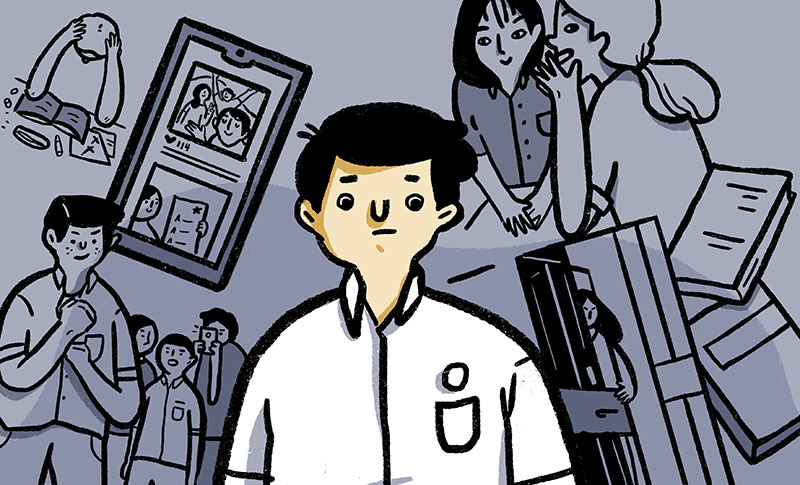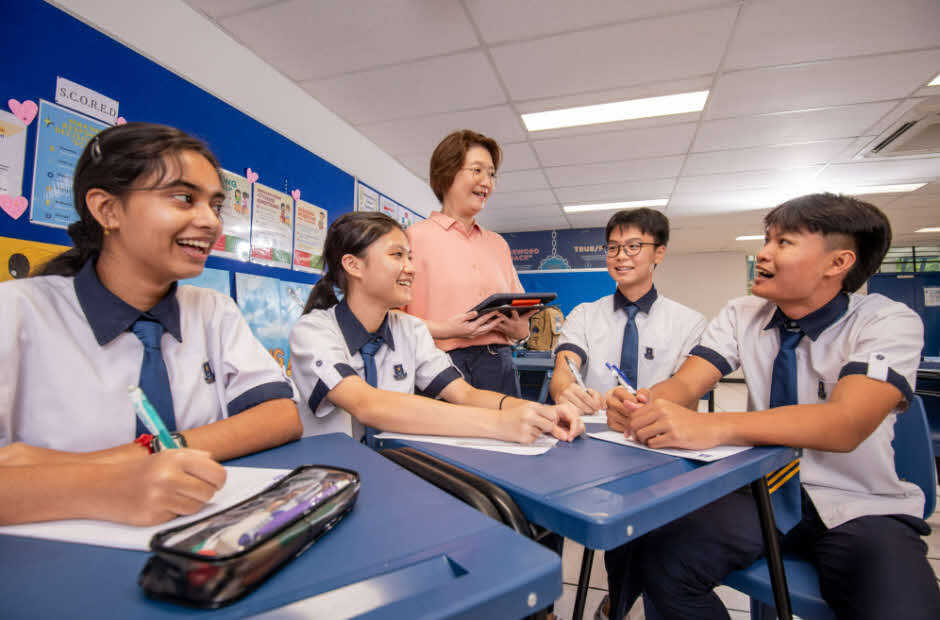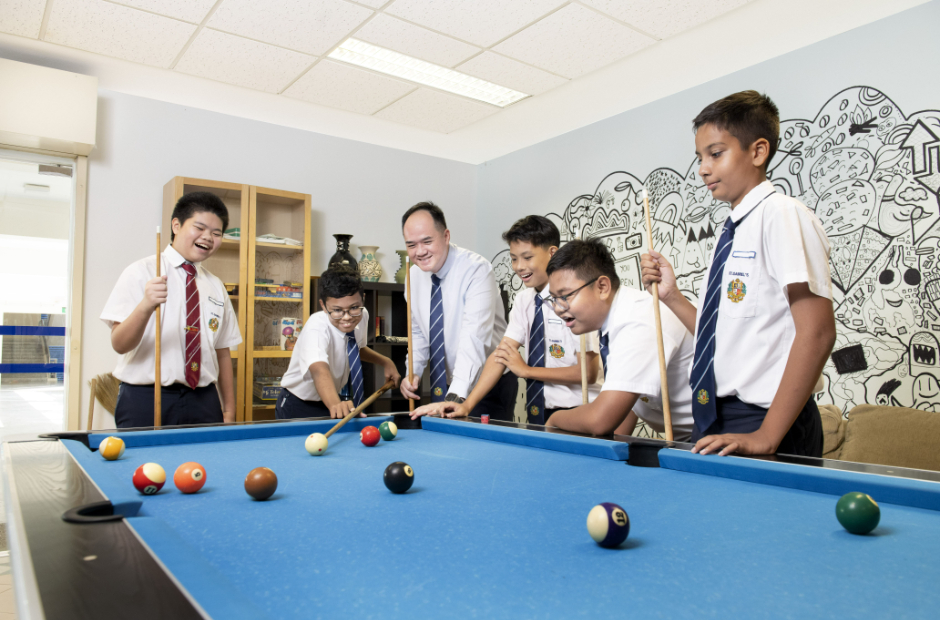Arivalagan S/O Rajangam, Greenridge Primary School, President’s Award For Teachers 2022 Finalist
Every morning, when Arivalagan S/O Rajangam — or Mr Ari as he’s more fondly known — steps into the classroom, his eyes sweep across the room. The moment he crosses his arms in silence, a flurry of activity ensues. It is time for ‘Everyday Responsibilities’. He believes all the students should play their part in keeping their personal space clean before he begins any lesson.
Insisting that his students take ownership of their personal space is only the tip of what Mr Ari does to promote individual accountability and social consciousness among his students. Through his robust efforts to promote Character and Citizenship Education (CCE) at Greenridge Primary School, these young students learn that their small actions can make a difference in the world.
“CCE is about doing the right thing, even when no one is watching,” he says. “Everyone must grow up with strong beliefs and convictions. They must be able to give a voice to the needy and vulnerable and be involved in inclusivity and conservation of their environment. “

From ego-centric to people-centric
Mr Ari joined the teaching fraternity fifteen years ago and has been heading the Character and Citizenship Education Department for the past ten years. He developed the school’s six-year Values in Action (VIA) Workplan outlining how students develop to become other-centric persons who actively contribute to the community.
“VIA is about stepping into someone else’s shoes, thinking from their perspectives, and making informed choices to impact others positively. What I would like to see in the students is a better version of themselves before they graduate from primary school,” says Mr Ari.
It is a tall order, and a profoundly important one for a generation that has not experienced hard times. Yet it isn’t insurmountable, as the programme is designed in a student-centric, age-appropriate and coherent manner with clear learning outcomes. The students’ sphere of influence and impact on others also broadens each year.
For instance, Primary 1 children are reminded to wash their hands and keep clean as part of learning personal responsibility. At Primary 2, the students learn to become ‘Dengue Fighters’. They learn about the harmful impact of mosquito breeding and conduct the five-step mozzie-wipeout at home to keep their homes mozzie-free. In Primary 3, the students learn proper skills to clean their personal spaces as well as common areas in the school.
“From Primary 4 to 6, the students start to exercise student agency in a structured manner through learning the design thinking protocol. “Students identify a school or community problem and develop creative solutions to solve it, hence demonstrating their heart to serve others,” explains Mr Ari. He and his colleagues in school have led the design thinking workshops for students.
“Schools cannot be institutions where students just come to study and get good grades. Teachers must play an active role in developing the students’ belief and values system, building their social and emotional competencies and encouraging their hearts to serve the community passionately.”
Students have since embarked on a wide variety of community projects. One group placed citrus peels in the school toilet to freshen the air. Another envisioned a paw-activated food dispenser for hungry stray cats in the community.
One particular project found its place in the community, encouraging pet owners to clean up after their pets. Students designed and put up advocacy posters at the lift landings of twelve HDB blocks near the school. The students’ efforts would have reached out to around 1,500 flats and up to 6,000 people in the vicinity.
Ari shares, “If someone sees the posters and brings a plastic bag the next time they walk their pet, you’ve succeeded. These are our students’ small yet meaningful contributions to build a better society for everyone to live in.” These community projects give students an authentic learning experience and embed the design thinking protocol in the students’ minds so that they can readily recall these experiences for future problem-solving.
“As teachers, we must walk the talk and be good role models for our students. That is an important part when teaching values,” says Mr Ari. During the food and clothing drives organised by the school, he would not just inform his students to encourage generous giving; he would also bring a bag of his own donations to class. He motivates the students to have a heart for the needy and collectively care for them. He also works with the nearby Residents’ Committee to rally support from the community for the donation drives.

Mr Ari, who also heads the school’s Partnerships Committee, has built a strong network of partnerships with community and corporate partners who add value to the students’ learning experiences. Recently, he arranged for the school’s Green & Innovation Club to partner Zhenghua Community Club and residents from the community for a tree planting event. The event allowed students to present their posters and beliefs on how the young are playing a role in environmental conservation.
Sharing an abundance mindset among the fraternity for the greater good
Mr Ari shares best practices from his school with the W5 Cluster CCE Champion Group, which he chairs. The cluster group consists of key personnel overseeing CCE from six primary schools. They come together regularly to have pedagogical conversations and develop resources to advance CCE education in all the schools in the cluster.
What defines Mr Ari’s leadership in this group is the belief that unrestricted information flow benefits everyone. Whether it is workshop modules on student leadership or learning materials developed on cyber wellness, all resources are shared freely among the cluster schools. Schools can further adapt the resources according to their own school’s needs and student profiles.
“I want to create an abundance mindset amongst teachers so that we can advance the fraternity together. As CCE teachers, we are teaching students the art of gratitude and giving. So, as teachers, we should also give and share generously,” says Mr Ari.
Touching lives the CCE way
Mr Ari concedes that it is not always easy to bring focus to a non-examinable subject like CCE, which includes National Education (NE) and Social and Emotional Learning. In primary schools, various components of CCE are taught through school-based programmes such as assembly talks and form teacher guidance periods (FTGP). While schools can decide how the time dedicated to teaching the different elements in CCE is used, Mr Ari does not take any chances with it. He ensures teachers spend quality time bonding and building positive teacher-student relationships during the FTGP lessons. It brings a smile to his face to see teachers conducting the FTGP lessons diligently or having a one-on-one session to get to know the students better during the teacher-student interaction time.
One notable example of the impact of CCE took place during an NE Show a few years back. It is a significant event on the NE calendar and one that all the P5 students look forward to. However, the father of one student who uses a wheelchair did not want to trouble the school with logistical issues and made his son sit out of it. Mr Ari talked to the boy and realised the boy was eager to attend the NE Show. So, he called the boy’s father to convince him to drive his son to the venue and worked with his NE Coordinator to make the necessary special access. He followed the child with his father to the venue and stayed with him till the end of the show.
Mr Ari recalls, “On the day of the NE Show, when I pushed the boy’s wheelchair to the arena, I saw the happiness on his face. When the fireworks lit up, both the boy and his father’s faces lit up with joy. It is fulfilling to realise then the difference we can make in other people’s lives. This, I thought, is the real influence and power of a teacher.”
The boy is a grown-up now. A few years ago, he came back to visit his ex-teachers. On seeing Mr Ari, he asked, ’Cher, remember? We went to the NE Show together?” Mr Ari felt contented that the boy still remembers the experience and that, deep in his heart, he is still grateful for the school’s efforts to make his wish come true.
For all the love he shares with his students and the teaching fraternity, Mr Ari cannot put the finger on what fills his cup. He reflects. “Maybe being able to do good for others fills my cup with positive energy and I look forward to going to work every day.”






